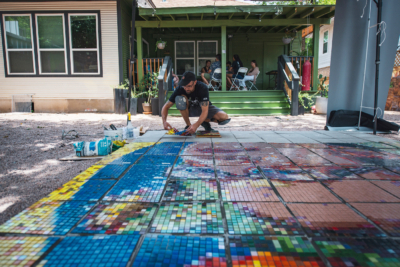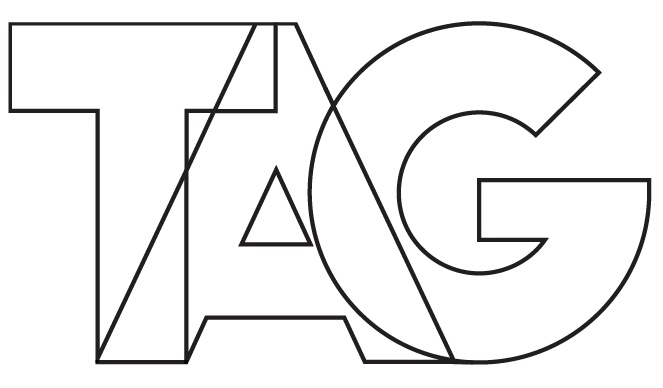Written by Diar Enayatpour, TAG Intern
Public art is a celebration of community that can embody the spirit of the people who occupy physical spaces. Artists are visual communicators who bring these collective values to life through large-scale work such as murals or mosaics. In collaboration with ACC Community and Public Affairs, The Art Galleries (TAG) at Austin Community College, the Latin American Cultural Center or “El Centro,” and the Arts & Digital Media Division hosted a hybrid event on April 17. This event took place at Highland Campus and via Zoom. Three artists spoke about their recent public art initiatives: J Muzacz; Julio Ávalos, also known as Chous; and Ana Flores Lavin. ACC Art Department Chair Bernardo “Bernie” Diaz introduced the artists and moderated the talk.

Susana Almanza, Process. J Muzacz using thinset to adhere the tile sections held together by strong mosaic tape to the stepping stone pavers. Photo by: Leta K
J Muzacz, is a prominent Austin artist and co-founder of the Mosaic Workshop. With a teaching career spanning a decade and with twenty-years of experience in public art, he has become a notable figure in the Austin urban art world. In his introduction, Muzacz discussed his contributions to public art, including his involvement with the Beaumont Mural Festival, a project aimed at elevating the work of mural artists. Through meticulous planning, Muzacz and his team address logistical challenges, ensure fair compensation for artists, and attract emerging and established talent. Alongside his other projects, Muzacz recently authored and edited a book called ATX urban art (2022) which chronicles urban art in Austin from the 1950s to the present. He highlighted the significance of documenting and curating street art, and cementing its place in the cultural landscape. In the main portion of his presentation Muzacz discussed the differences between grassroots public art, official civic art public art, and commercial public art.
It is clear through the way he talks about his practice that community engagement lies at the heart of Muzacz’s work. He advocates for a collaborative approach to art-making, where meaningful subject matter inspires celebration and fosters a sense of belonging. Emphasizing grassroots initiatives, he relies on grants and volunteers to fund and execute projects that convey a meaningful message. Often taking on projects that end up costing him more than the initial grant or funding, Muzacz emphasized the importance of public art to beautify and preserve civic pride. One notable example is his work in Flint, Michigan, where he revitalized vacant lots and buildings by highlighting urban farms and community spaces. By involving local residents in the creation process, Muzacz not only beautifies the environment but also empowers the community to take ownership of their surroundings. By blending digital art with mosaic murals, the boundaries of creativity and artistic expression can be prolonged through the durable medium of mosaic.

Murals by Chous, Saltillo, Mexico. Image courtesy of the artist.
The next presentation was given jointly by visiting artists Ana Flores Lavin and Julio Ávalos (aka. Chous) who shared their contributions to Mexico’s public art scene. Ana began her talk by explaining her background as a graphic designer, artist, and cultural manager. Based in Austin’s sister city of Saltillo in Coahuila, Ana and Chous work together to facilitate a program called Color de Mexico.
This project centralizes the recovery of public urban spaces through large-scale murals. Utilizing art as a form of crime prevention they operate workshops for young artists across Mexico in cities, namely Mexico City and Monterrey. They host open calls and invitations, creating networking opportunities for young artists to explore their creative avenues while expressing themselves. In a small town in the state of Michoacán, known for its high rates of cartel-related crime, Lavin and Chous oversaw one of their largest projects. Thirty houses were selected to be painted, and young artists were connected with the homeowners and consulted for design inspiration throughout the process. Incorporating the homeowner’s taste and wants through the use of vibrant colors, organic shapes and animals allows each painting to be unique while remaining cohesive when viewed altogether. By engaging the community to create the murals collectively a stronger sense of belonging inhabits their decorated public spaces. Another project that Lavin and Chous are managing for the sixth consecutive year, Harto Arte International Urban Art Festival. Funded by the state government of Michoacán and held in the Capital City of Morelia, Harto Arte brings together artists from all over the world as the third largest Mexican urban art festival. During the festival artists are given space to collaborate, create, and celebrate urban art.
The work of Muzacz, Chous, and Lavin exemplifies the power art holds, which can be used to honor community, revitalize public spaces, and uplift young artists. Although these artists utilize different mediums, they all share the same goal with their practice: to visually engage with their communities and to activate spaces in their neighborhoods through creating meaningful public artworks. Whether they are working on independent commissions or founding festivals in Texas or Mexico, Muzacz, Chous, and Lavin are raising the bar on our perception of what public art is and can be.
To watch the entire talk, visit our Video Archive.
More about these artists and their projects:
Learn more about Muzacz’s Mosaic Work Shop, the ATX urban art publication, and his involvement in the Beaumont Mural Festival.
See Chous and Lavin’s newest mural in Austin at Mexic Arte Museum
View artist website and social media profiles here:


Recent Comments